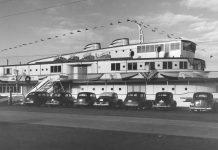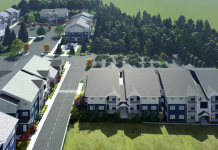We all understand that community development benefits jobs, local businesses and the regional economy. But how exactly does that happen? As with most projects, the driving force—and perennial stumbling block—is funding. In our area, Heritage Bank has created their very own Community Development Entity with the aim of financing businesses in economically distressed areas to breathe new life into neglected and underserved communities.

The U.S. Department of the Treasury explains that “A Community Development Entity (CDE) is a domestic corporation or partnership that is an intermediary vehicle for the provision of loans, investments, or financial counseling in low-income communities.” It also allows the bank to participate in the New Markets Tax Credit Program that “incentivizes community development and economic growth through the use of tax credits that attract private investment to distressed communities.”
This is a powerful combination. The New Markets Tax Credit Program has, according to the Treasury Department as of 2020, “Generated $8 of private investment for every $1 of federal funding, created more than 368 million square feet of manufacturing, office, and retail space [and] financed more than 9,500 businesses.”
Heritage Senior Vice President Daryl Fourtner says that their program, which launched in the fall of 2020, was a long time in the works but he’s glad they now have another tool available when looking to meet the needs of the community. “We wanted a seat at the table as a bank, so we created our own program in-house as a subsidiary of Heritage Bank. This way we can deploy capital into the community where it’s needed.”
Applicable projects must be commercial, not residential, though some mixed-used development is allowed. They hope funding local growth will “encourage business expansion in low-income communities through capital injection and job creation,” says Fourtner.

It’s just a—relatively simple for the financial world—three-step process. For example, if your company is hoping to move or open a second office, Heritage Bank maintains a geographic mapping tool showing which areas are deemed eligible based on local census data. Select a location within that area, own a commercial enterprise and use at least 25% of funds borrowed on building repair, improvement or construction and you’re well on the way to funding.
The benefits to using this CDE loan fund mean borrowers often get below-market fixed rates, lower fees, longer maturities and seven years of interest-only payments so your business can settle in and find its feet. Versus a $1 million conventional loan with an estimated monthly payment of $4,038, a conventional HBCDE payment would be $1,875 plus a savings of more than $3,700 in fees and closing costs.
There are similar loan programs on the federal level, like the Small Business Administration’s SBA 504. But, say industry experts, “With their low-interest rates, long terms and relatively small down payments, 504 loans are an ideal option for small-business owners who want to make big purchases—if they can qualify and afford to wait for funding. Like most government small-business loans, SBA 504 loans have stringent requirements and a long application process. Closing can take several months.”

Currently, Heritage Bank’s CDE loans charge 3% interest versus the SBA’s rate of 4.25% and climbing. Some of their first funds were out the door in 2021 and Fourtner encourages folks to come to visit with questions or about the mapping tool. “We welcome the opportunity for folks to reach out directly, the website can be overwhelming,” he adds. “We’ll help you find your own path; we’re very much hands-on not just online.”
For most commercial projects the turnaround time to get an HBCDE loan is between 60 and 90 days. It keeps local money working within the region. “And that’s win/win,” says Fourtner. “Not just the cliché, but real economic benefit. It helps the community and that’s something we’re all about.”
It’s estimated that every dollar spent locally keeps 70 cents stays within the community. Now imagine that statistic applied to not just money but jobs, neighborhood improvement and bettering the lives of your friends and family. Heritage Bank’s CDE works to do just that by lending in a thoughtful, mindful way where it’s needed most. Make an appointment to see how it can benefit your business today.
Sponsored



































